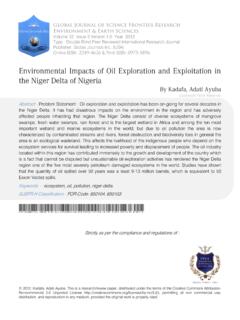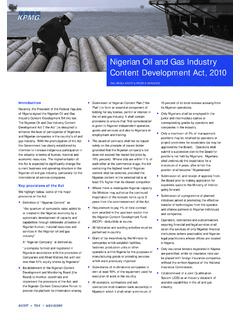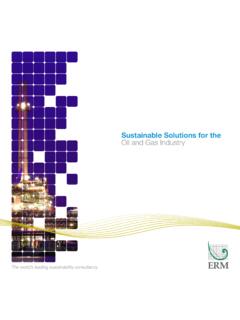Transcription of Financing options in the oil and gas industry
1 Financing options in the oil and gas industry , Practical Law UK Practice 2018 Thomson Reuters. All rights options in the oil and gas industryby Suzanne Szczetnikowicz and John Dewar, Milbank, Tweed, Hadley & McCloy LLP and Practical Law notes | Maintained | United KingdomScope of this noteIndustry overviewUpstreamWhat is an upstream oil and gas project?Typical equity structureRelationship with the stateKey commercial contracts in an upstream projectSpecific risks in Financing an upstream projectSources of Financing in the upstream sectorMidstream, downstream and integrated projectsTypical equity structuresWhat is a midstream oil and gas project?Specific risks in Financing a midstream projectWhat is a downstream oil and gas project?Specific risks in Financing a downstream projectIntegrated projectsSources of Financing in midstream, downstream and integrated projectsMulti-sourced project financeShareholder fundingEquity bridge financingAdditional sources of financingOther Financing considerations for the oil and gas sectorsExpansion financingsHedgingRefinancingCurrent market trendsA note on the structures and Financing options and risks typically associated with the oil and gas options in the oil and gas industry , Practical Law UK Practice 2018 Thomson Reuters.
2 All rights of this noteThis note considers the structures, Financing options and risks typically associated with the oil and gas industry . Itis written from the perspective of a lawyer seeking to structure a project that is capable of being financed and alsoaddresses the aspects of funding various components of the industry from exploration and extraction to refining,processing, storage and addition, this note considers the typical features of oil and gas Financing including the fact that such projects: Can be on a very large scale. Often take many years from inception to the point at which the end product is sold to consumers. Almost invariably involve government bodies. Are subject to certain specific risks over and above those more generally found in a project Financing note is intended to provide an overview for those advising on the Financing of projects in the oil or gas industries,or to those who are seeking to understand the typical structures and risks involved in oil and gas more general information on the nature of gas and/or oil projects, see Practice notes: Downstream gas industry : overview.
3 Downstream gas sector: terminology. Financing liquefied natural gas projects. Anatomy of a gas-fired power project. International joint ventures: oil & overviewThe oil and gas industry underpins many national economies through: Its supply of energy to industry and the domestic end consumer. The export and import of raw materials, and derivative manufactured and refined products. Job creation. Revenue generation. Furthering of inter-governmental connections and trade links. The generation of royalties and tax industry is typically divided into three major operational components: Financing options in the oil and gas industry , Practical Law UK Practice 2018 Thomson Reuters. All rights Upstream (or exploration and production (E&P)). Midstream. overview of the various components of the industry is set out below:Providing access and exploration rights to, and consequently monetising, a country's hydrocarbons alongside thedevelopment of transportation and processing facilities for such products can be of considerable benefit to a nationaleconomy.
4 Private sector technical expertise and equity investment potential is leveraged alongside the participationof state-owned national oil and gas companies (NOCs) to maximise the benefit obtained by the relevant state (aswell as the equity investors) and to enable the NOCs to grow their technical participants in the oil and gas industry include: International oil companies (IOCs) and other corporate entities, who have historically dominated this sectorand who are distinguished by market capitalisation into: super majors (for example, ExxonMobil, BP, Shell and Total); majors (for example, ENI and Repsol); andFinancing options in the oil and gas industry , Practical Law UK Practice 2018 Thomson Reuters. All rights mid-cap/independents (for example, Ophir, Tullow, Noble Energy and Premier Oil). NOCs (for example, Saudi Aramco, Qatar Petroleum, ADNOC, Petrobras, Gazprom, CNOOC, PETRONAS andKNOC). Global traders (for example, Glencore, Vitol and Trafigura). Private equity and hedge funds (for example, Blackstone, Carlyle and Och-Ziff).
5 State-owned investment funds (for example, China Investment Corp and IPIC). Pension funds and insurance companies (for example, OMERS and Ontario Teachers). Services companies (for example, Nabors, Schlumberger, Halliburton and Seadrill). Shipping companies for liquefied natural gas (LNG) and other hydrocarbons (for example, Golar, GasLog andMitsui). Industrial manufacturing companies and refiners (for example, The Dow Chemical Company, RelianceIndustries and Essar).In view of the capital intensive nature of oil and gas projects and the varying degrees of risk to which stakeholdersare exposed (in part, depending on the stage of a project's development and operations), equity investors typicallyrequire different sources of Financing over the life of a project. Key Financing options employed include: Equity sources. IPOs, cash calls (under a joint operating agreement (JOA) (see Key commercial contractsin an upstream project)), shareholder loans and share subscriptions. Third party Financing products.
6 Corporate loans, acquisition Financing , reserve based lending (RBL),equity bridge loans (EBLs), project finance, capital markets, hybrid financings and hedging. Other sources. Operational current or future cashflow and the raising of funds through asset feature common to many of the above in an oil and gas context is the detailed technical, legal, market, financialand regulatory due diligence carried out on what can often be complex and bespoke projects. A petrochemicalscomplex comprising multiple interconnected units, such as the Sadara petrochemical plant in Saudi Arabia, forexample, requires a comprehensive understanding of, among others, the interface risk in construction and operation,the licensing and technology arrangements and the relevant product markets and sales arrangements. In addition,rigorous environmental and social standards are expected by debt and equity financiers alike to avoid the occurrenceof catastrophes of significant commercial or reputational consequence (or both).
7 As is the case for other large-scale projects, factors framing the risk assessment for an oil and gas project and, inturn, the availability of Financing , include: The type of project and the nature of transaction. The project's location and consequential political, legal, regulatory, economic, social and environmentalconsiderations. The identity, creditworthiness, existing liabilities and contractual rights and obligations of key projectstakeholders and participants, including the sponsors, offtakers, feedstock suppliers, regulators, contractors,utility suppliers and operator (as applicable). The availability and coverage of options in the oil and gas industry , Practical Law UK Practice 2018 Thomson Reuters. All rights Individual institutional requirements (for example, capital reserve allocations) and risk appetites (for example,country risk, environmental and social responsibility, source of funds and sanctions regimes).Over time, the industry has established means of addressing these risks to facilitate the structuring of "bankable"projects through the adoption of recognised frameworks with modifications required to ensure financiers are ableto obtain internal credit approvals to proceed.
8 For further details on risk factors, see Practice note, Identifying andmanaging project finance risks: overview (UK).UpstreamWhat is an upstream oil and gas project?The upstream sector is also known as the E&P division of the business. Activities consist of: The exploration of reserves. The drilling and evaluation of the commercial viability of wells. The recovery and production (including initial processing) from is recovered for onward transportation and processing utilising midstream and downstream infrastructurethrough which crude oil, natural gas and other related natural resource by-products such as condensates, ethane,propane, butane and sulphur are ultimately deposits are typically confined at high pressure within rock formations. Drilling into these rocksalleviates the pressure and enables extraction of the relevant natural resources. Reserves may be located deepunderground on land (known as onshore) or under the seabed on the continental shelf (known as offshore).
9 Thecountry within whose borders fields are located usually retains sovereignty over them. See Key commercial contractsin an upstream an offshore context, upstream activities can be performed by way of drilling rigs from an offshore platforminstallation or a vessel. Floating production storage and offloading units (FPSOs) are often used to exploithydrocarbons offshore. These are floating vessels which receive the relevant hydrocarbon(s) either from nearbyplatforms or from direct production for processing, storage and onward transportation (by vessel or pipeline).Vessels can be preferred by financiers and equity investors to pipelines depending on the ultimate location of theofftaker and localised geographical , and more recently used to recover hydrocarbons including shale gas from onshore sources, "fracking"refers to a process of drilling (often horizontally) into the earth before releasing a high-pressure water mixture torelease natural gas trapped within.
10 For a guide to Practical Law's key materials on the extraction of shale gas usinghydraulic fracturing, see Shale gas equity structureFinancing options in the oil and gas industry , Practical Law UK Practice 2018 Thomson Reuters. All rights is unusual for a single sponsor to finance, develop and operate an upstream field, except if the field is small-scale orthe sponsor has sufficient balance sheet Financing capability. The latter may be the case in the pre-production phaseof a field's exploration as this can be difficult to finance through third party means. Investment in upstream projectsis arguably more risky and less predictable than downstream oil and gas ventures, as the amount of cash requiredto monetise an upstream resource and the timing of such investment contributions will not always be apparent atthe unincorporated joint venture (UJV) is the more commonly used structure to access sources of upfront equityfinance and spread the cost (and risk) amongst out below is an upstream UJV structure showing the equity parties to a JOA and examples of the key governmentand commercial contracts that are customarily put in place.







